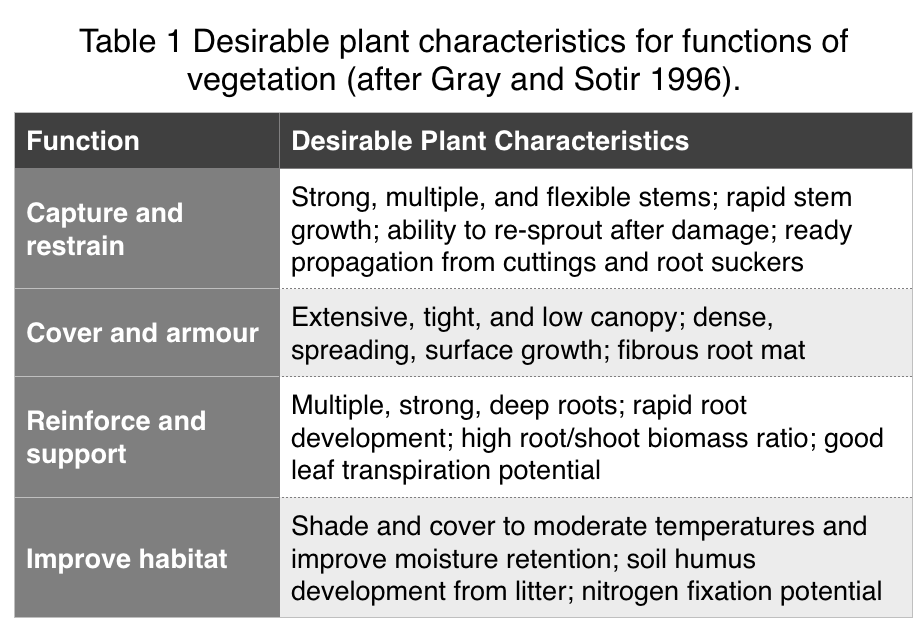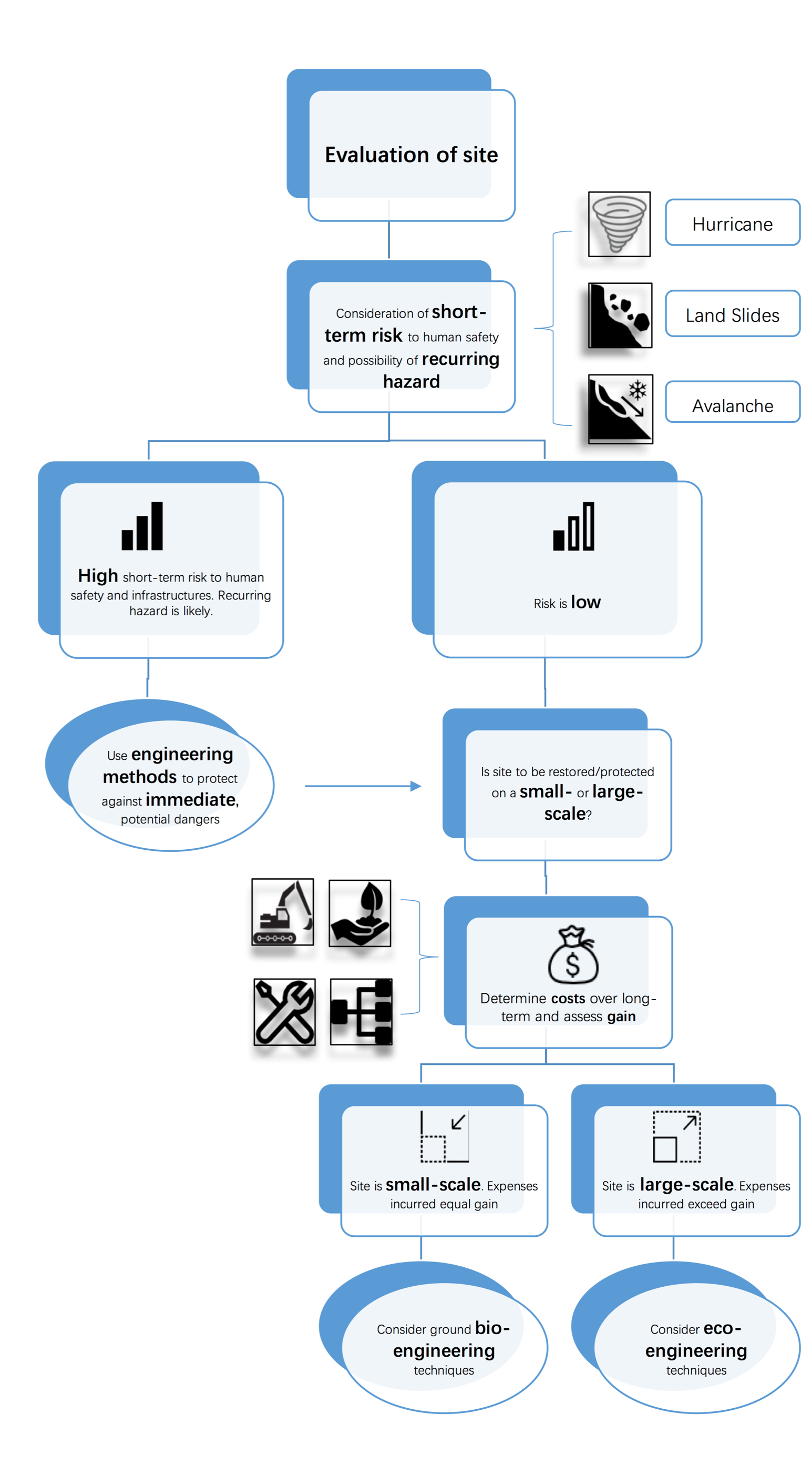What’re BMPs of erosion control?
Actually, erosion control BMP is a part of stormwater strategies for preventing soil moving from the original location (e.g., construction sites and roadside slopes), and it is usually combined with Sediment Control BMP which is to arrest the soil already eroded. Generally speaking,
Erosion Control BMP = stop soil moving from original location;
Sediment Control BMP = trap soil that’s already moved.
Therefore, an effective erosion and sediment control plan should consider a multi-barrier approach so that the second line can trap the sediment when the first line of soil retention failed.
Vegetation would be a good BMP of erosion control. Although there are many different forms and structures of plants, in general, the elements that can bring a positive contribution to slope stability can be divided 3 types:
1. Roots, to retain the soil and absorb water and nutrients from the soil.
2. Stems, to provide support for the above-ground parts and arrest eroding soil.
3. Leaves, to intercept precipitation, lead to evapotranspiration reducing soil moisture (Coppin and Richards 1990).
Different types of plans can function on stabilization in different levels. The table below indicates desirable characteristics for the expected functions of vegetation. Each species will show different levels and patterns of performance and support different amounts of above-ground biomass depending on the site context and climate conditions. Main types of vegetation can be divided four categories, Grasses, herbs, woody plants and shrubs, and trees. Conservation practices that provide immediate permanent cover (sod) or provide intermittent cover (mulches and permanent seeding) dramatically reduce soil losses and runoff (Figure 1).

Using ground bio- or eco-engineering techniques
Live vegetation and inert plant materials have been widely used for erosion control and also to stabilize slopes and restore degraded sites and river banks over the world, but generally using local knowledge and lacking specific scientific criteria. In the last few decades, due to the increasing concern of environmental restoration and conservation from the public and scholars, bio-engineering and eco-engineering techniques have developed rapidly, and there are many case studies can prove the feasibility and effectiveness of the techniques (Stokes, A., 2007). Both ground bio- and Eco-engineering techniques utilize the same biological materials (mainly plants and vegetation) as critical tools in BMPs of erosion. For this reason, in many cases, they are complementary with each other but which technique is appropriate for the site should be evaluated carefully, and the selection of vegetation species should also comply with different criteria for two techniques. When it comes to decide which technique should be adopted, engineers have to determine the site conditions such as the nature of the slope, type of soil, type of native or desired vegetation and the possibility of any hazardous natural events which would affect the slope stability and any other key factors of soil erosion during the restoration time. The flowchart flowing shows a conceptual framework of eco-engineering implementation:

(Norris, J. E.. . ebrary eBooks 2010)
It’s very imperative to underscore the cost benefits of the technique before project implementation. Risks, costs, size, gain and geographic factors are necessary considerations in deciding the choice of a technique. As outlined in the framework, the use of ecological engineering techniques for erosion control might not be the best option under certain conditions. Especially, under conditions where human lives are at risk, engineers and policy makers must focus on civil engineering techniques to reduce the potential risk of death before considering ecological engineering strategies are considered. Under the cost factor, engineers must appraise the cost of various options in terms of planting costs, maintenance, compensation and relocation if necessary. Feasibility analysis of species adaptability to the ecological environment and well public acceptance are essential factors of consideration during the planning and implementation the erosion control strategy.
Differences from bio-engineering techniques and eco-engineering techniques:
Ground bio-engineering techniques typically combine with civil engineering techniques, utilizing natural or man-made materials to arrest soil run-off, planting fast-growing herbaceous species to fix soil to establish a protective layer, which has effective and economic characteristics. However, the selection of vegetation species is difficult. In addition to the ability to adapt the circumstance, performance of the root system in fixing and reinforcing soil on an unstable slope and long-term risks for application location should be evaluated as well. For instance, due to grasses often wither in the summer, shrubs should be applied to avoid slippage or erosion issues during that period of time, but shrub and trees that are able to grow taller over a longer period of time will cause the decline of shade intolerant species.
As the flow chart indicated above, applying bio- or eco-techniques is depending on the site scale. If the site is large-scale, e.g., a mountain slope, the expenses caused may be too high to implement certain bio-engineering techniques, which is hard to be balanced with the gain produced. Therefore, in this case, eco-engineering techniques that can be introduced. Compared to bio-engineering techniques, Eco-technology that integrates human society with its natural environment and involves mostly creation and restoration is a long-term method to manage ecosystems to minimize the costs of measures and their harm to the environment based on deep ecological understanding. For instance, “A mountain protection forest should consist of broadleaf species, the number of wild ungulates should be limited and thinning and falling should be carried out with care”( Motta and Haudemand 2000). “Similarly, in conifer forests subjected to frequent storms, the upwind border of the stand could be planted with broad-leaf species and pruned to create a ‘ramp’ or shelter-belt type structure. Such a structure will cost little to maintain and will allow the prevailing wind to pass over the stand rather than penetrate”(Quine et al 1995). The two scenarios above was used in the general forest management context. But it gives a clue as to why engineers seeking to use ecological engineering techniques to address erosion problems have to have the in-depth understanding of the ecological dynamics of the site.
Although it is now necessary to repair the damage caused by environmental degradation, many countries, particularly developing countries, are unable to implement environmental restoration project of degraded lands due to its high investment. Based on the characteristics mentioned above, Eco-engineering can be an available option, providing a cost-effective, low-risk, long-term solution in certain cases.
Planting Native Plants
Species selection is one of the fundamental considerations in soil restoration. Selecting native plants will optimally increase the success of the restoration program and remarkably decline the long-term maintenance requirements. Besides, compared to the civil engineering solution that usually has potential risks causing other environmental issues, planting native plants is a cost-effective way to minimize dark sides of the restoration project. Species applied for conservation of soil properties and promoting soil stabilisation should meet the following criteria:
- pioneer plants which grow rapidly on degraded land, landslides, gullies and new road slopes;
- dense and deep rooting systems which add strength to the topsoil and increase the shear strength;
- adventitious rooting ability and coverage resistance;
- fast and simple propagation such as cuttings and their application in the dormant season (Weigel et al. 1987; Lammeranner et al. 2005).
Compared with the civil engineering techniques, what are benefits of bio- /eco-engineering?
Many civil engineering practices such as soil nailing and geosynthetic reinforcement, which have well-defined engineering parameters are widely used, marketed and are more commonly accepted by society and contractors (Franti 1996) especially for stabilising infrastructure slopes, and man-made materials, e.g., Polyester netting, are generally applied in civil engineering erosion control. As you can see from the diagram above, compared to bare soil area which is most vulnerable to erosion issue, the site protected by polyester netting can be effectively controlled soil loss. But when it comes to other biological approaches such as planting grass sod, civil engineering technique still has a high level of soil loss. Therefore, based on the comparison civil engineering practices, it is safe to say that bio- or eco-engineering techniques have a measurably better performance.
Here is a link to provide suggestions on guidelines. URBAN SOIL EROSION GUILD-LINE
Reference:
- Norris, J. E., Stokes, A., Mickovski, S. B., Cammeraat, E., van Beek, R., Nicoll, B. C.. . ebrary eBooks. (2010). Slope stability and erosion control: Ecotechnological solutions: Ecotechnological solutions. New York: Springer.
- Coppin, N. J., & Richards, I. G. (1990). Use of vegetation in civil engineering. Construction Industry Research and Information Association.
- Gray, D. H., & Sotir, R. B. (1996). Biotechnical and soil bioengineering slope stabilization: a practical guide for erosion control. John Wiley & Sons.
- Motta R, Haudemand J-C (2000) Protective forests and silvicultural stability. An example of planning in the Aosta valley. Mt Res Dev 20:74-81
- Quine CP, Coutts MP, Gardiner BA, Pyatt DG (1995) Forests and Wind: Management to Minimise Damage. Bulletin 114. HMSO, London
- Stokes, A., Spanos, I., Norris, J. E., & Cammeraat, E. (Eds.). (2007). Eco-and Ground Bio-engineering: the Use of Vegetation to Improve Slope Stability: Proceedings of the First International Conference on Eco-engineering 13-17 September 2004 (Vol. 103). Springer Science & Business Media.
- Franti TG (1996). Bioengineering for hillslope, streambank, and lakeshore erosion control. Available from: http://www.ianr.unl.edu/pubs/soil/g1307.htm, 1-7